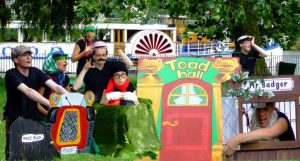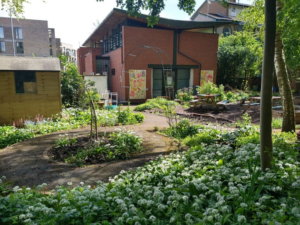It is important children are taught to respect all forms of plant and animal life, so they should learn to study plants in the field without damaging them and treat animals with care, never mistreating or killing them.
Samples can be obtained from a pond by ‘dipping’ from a specially made platform. Useful equipment includes:
- Shallow white plastic trays and plastic pots
- Long handled nets
- Spoons to transfer the creatures
- Hand lenses and/or microscope
- Invertebrate identification sheets
- Pencils and paper
- Observer’s Book of Pond Life or similar
If there is no safety barrier at the water’s edge, advise people to lie on their front while dipping. This stops anybody toppling in.
Empty some pond water into the trays. Dip a net into the pond and run it gently through weed or near the bottom of the pond. You can also gently disturb the plants at the edge of the pond and see if anything emerges which you can then scoop up in your net. Do the same with the plants under the water on the sides of the pond. Empty the contents of the net carefully into the tray and allow them to settle. The creatures being looked for are small and easily damaged but when the silt has settled they should be visible moving around. Collect them with a spoon and place them in a clean container (a yogurt pot or margarine tub) with some pond water and look at them carefully. Use the hand lens and identification sheet and record what you find. Do not keep the creatures out of water for too long and return them carefully to the area of the pond they came from. Encourage the children to look at the books and find out more about what they found.
Traps
Only use these if you can be absolutely sure you can go back and check them and release any captives.
To create a small ‘lobster pot’ trap, cut the top third off a plastic drinks bottle, bait the main part with meat or pet food and add a handful of stone to weight it down, push the cut off top part back into the baited part with the neck pointing into the bottle. Attach it securely to the bank with a line which you can use to pull it back in.
Ensure all traps are emptied and brought back in from the water so no creatures are left trapped.
Pond Dipping Platforms
Expert advice is required to ensure that pond dipping platforms are safely designed and constructed. Use hardwoods, pine or larch which contains natural resins that help preserve the wood. Tanalised wood contains preservatives which may put poisons into the water and will kill the animals you want to study. Alternatively an alloy frame can be used with timber decking.
Some species of wood are particularly good for damp or wet situations (notably alder) and others whilst good, have a tendency to sprout (eg willow). Chicken wire, stretched and firmly tacked onto the platform is a good way of ensuring the surface does not get slippery.

Reproduced with permission of North West Parks Friends Forum







